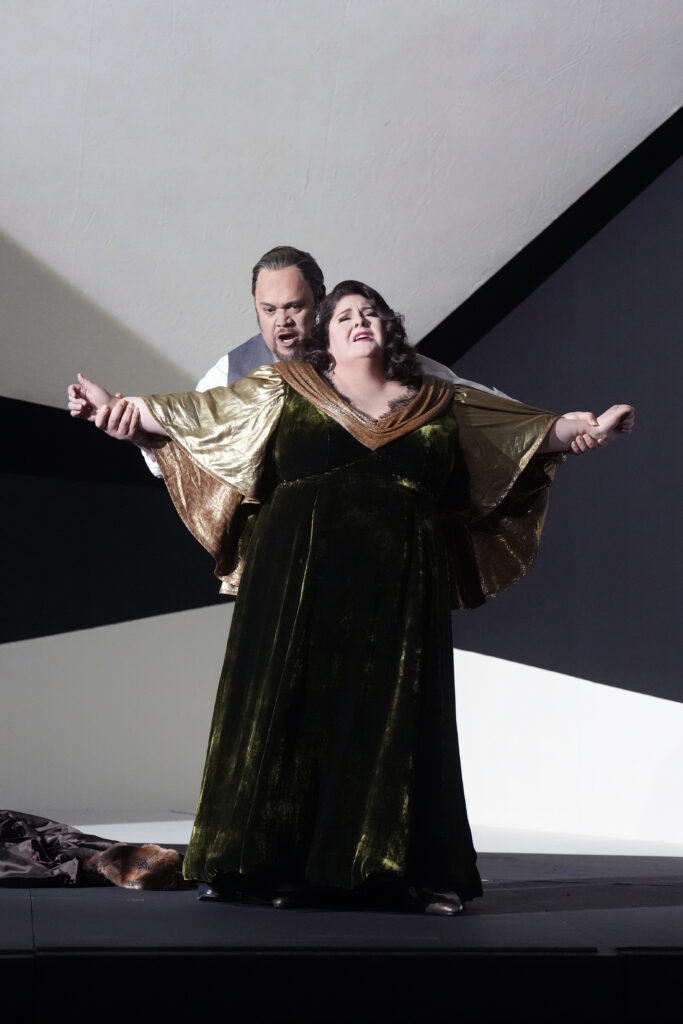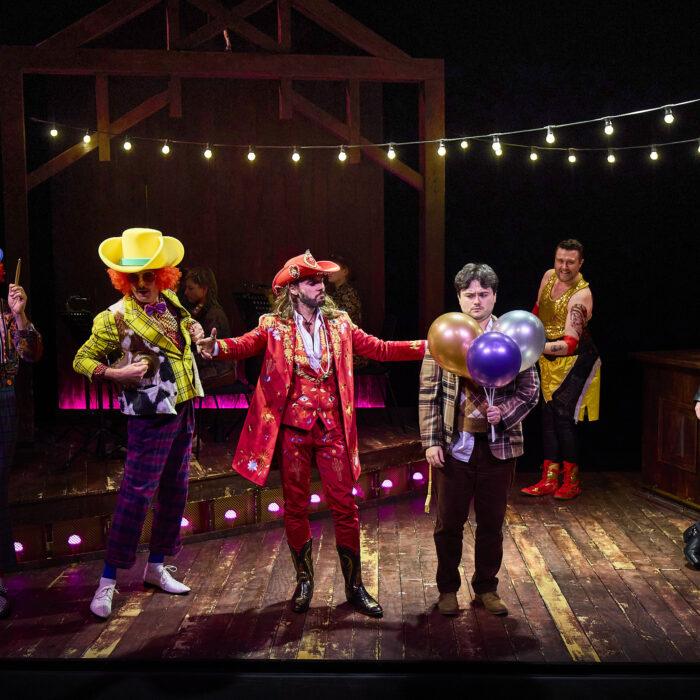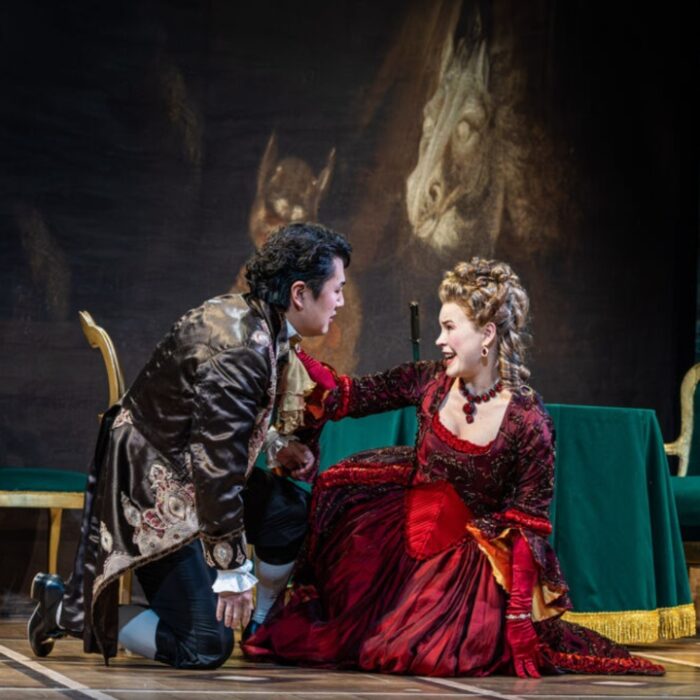
Metropolitan Opera 2023-24 Review: Un Ballo in Maschera
Charles Castronovo Gives Stellar Performance in David Alden’s Lamentable Production
By Francisco Salazar(Credit: Ken Howard / Met Opera)
The Metropolitan Opera is in the midst of reviving “Un Ballo in Maschera” for the first time since 2015. Considered one of Verdi’s masterpieces, the work has some of the greatest arias and ensembles the composer ever wrote.
For this revival, the Met brought a solid cast in an unfortunate production that should have never been allowed on the Met stage in the first place.
A Disjointed & Forgettable Production
When the production first premiered in 2012, I found it immensely distracting by attempting to transform Verdi’s tragedy into a comic operetta. Eleven years later, things haven’t improved at all. In fact, they’ve gone in the opposite direction.
The production is made up of a silver box in Act one, a small black and white box in Act two, and a mirror hall that creates the images of a castle. The first acts look tired and dull, while the final set, while visually attractive, is ultimately disjointed from the other two sets. All three sets have a painting of Icarus on the ceiling and while there is an attempt at symbolism about the Icarus story, it just doesn’t add much to this particular opera. There is also a chair that is left on stage right throughout the entire night.
The biggest issue with this production, however, is the hyperactive direction. In Act one, as King Gustavo sings, there are butlers bringing in papers and throwing them on desks. As Oscar sings his first aria, there is some uncoordinated dance. When Ulrica comes on stage, the chorus is forced to dance like possessed creatures. When King Gustavo arrives with his entourage a few moments later, they are dressed in raincoats with umbrellas dancing like it’s “Singing in the Rain.” In Act two, as Amelia is singing her first aria (one of the opera’s most dramatic moments), Alden has dancers with knives jumping around the stage. Then during Gustavo and Amelia’s duet, skeleton heads appear and as they declare their love, the backdrop opens to reveal a farm. In Act three, Renato’s fury is demonstrated through throwing a sword twice and throwing a portrait of Gustavo. In a crucial ensemble, Count Horn is made to throw papers like an insane man, and Christopher Job, who was portraying the role on this night nearly slipped on the stage due to the mess of papers. Then at the end of the scene, Job was forced to scribble on Gustavo’s painting. The actions made a caricature of this dramatic moment where Verdi masterfully balances Oscar’s playful lines with Renato’s march-like music and Amelia’s anguished coloratura line. In the final scene, the ballet is once again a bunch of dancers jumping around the stage randomly and during Oscar’s aria, there is a can-can-like dance that looked utterly uncoordinated and underrehearsed. The worst offender of the night however was the final ensemble. As the angelic music crescendoed to its climax, Alden decided to close the panels of the production, and a screeching noise distracted from the moment.
Ultimately watching this production created a feeling that the director saw the opera as so utterly lacking in dynamism that he had to manufacture consistent stage motion to give it some energy. Movement is not the issue here, but the frequency of it, which not only becomes laughably predictable (the only real tension comes from the guessing game of what kind of movement will he bring in now), but the resulting diminishing returns. Contrast of stillness were needed and this production regrettably lacked many, creating something that felt sloppy and unintentionally silly.
Fortunately, this production is not sticking around any longer. According to a recent interview, the Met is planning a new production of “Un Ballo in Maschera” in a future season. Hopefully it has a greater sense of purpose and true dynamism.
A Multi-faceted King
Charles Castronovo brought his acclaimed Gustavo to the Met for the first time. Since his debut in 1999, you could say this is his biggest assignment yet and he didn’t disappoint. While his opening aria “La rivedra nell’estasi” was uneven as his higher register seemed to stretch his capacities, he warmed up to create an immaculate portrayal of the king. Following that aria, Castronovo’s portrayal of Gustavo was jovial as his voice took on a lighter timbre, especially during “Ogni cura si doni al diletto,” where the tenor’s agility was noticeable. During this ensemble, Castronovo relished in the physicality of the role dancing alongside the chorus.
In the second scene of the opera, dressed as a fisherman, he delighted in making fun of the fortune teller Ulrica, playfully looking at the chorus and stuffing a note in a sailer’s jacket. His voice continued to have a gleaming quality. It is was not until the trio that Castronovo showed his dramatic vocal qualities, delivering a passionate timbre, the voice seemly opening up. During “Di’ tu se fedele,” the tenor opened with a smooth line that soon turned mischievous as he mocked Ulrica. He moved about the stage joking with the chorus. The vocal line, while sometimes unsteady at the top, showcased short staccato accents and rapid patter-like rhythms. You could sense the fun Castronovo was having. Even in the second aria, “E scherzo od e follia,” the tenor continued this playful quality. Not once did his portrayal play off the usual hesitance that is generally shown and instead it seemed like he was mocking the prophecy. His tone was in contrast from Olesya Petrova’s dark and foreboding singing and the chorus’ short lines.
In Act two, Castronovo’s youthful king turned to pure, unadultered passion as he sang the duet “Teco io sto” with ardent tone that easily filled the hall. The high notes gleamed with clarion sound and the lines were filled with ardor. His “Non sai tu che se l’anima mia” started with a serene quality that slowly crescendoed to “Quante volte dal cielo implorai La pietà, che tu chiedi da me! -” both filled with exhilarating high notes that expressed the love that Gustavo felt for Amelia. Castronovo’s passion only grew as the duet developed and he let out an impassioned high note at the end. In the trio that passion turned to remorse. His lines “Traditor, sciagurati son essi” were filled with an airy quality and fast, articulated notes. As his line ended, he slowed down the music and sang a deep low note.
The opening recitative of Act three, “Forse la soglia attinse,” featured the tenor showcasing the full force of his tenor, stretching his voice to the full extent. However, when he sang “Ma se m’è forza perderti,” he delivered a smooth Italianate sound. His highs gained weight and his desperate character was emphasized, particularly on the lines “Nell’intimo del cor” and “Come se fosse l’ultimo.” He shaped them with a gorgeous pianissimo sound that he then crescendoed to fortissimo. The ensuing phrase “Sì, rivederti, Amelia” was delivered with pure intensity.
In the final ensemble after being stabbed, Castronovo brought a pure and gorgeous piano sound, especially on the phrases “Io che amai la tua consorte” and “Io l’amai, ma volli illeso.”

Credit: Ken Howard/Met Opera
A Married Couple
In the role of Amelia, Angela Meade had an uneven first half. Over the years the soprano’s voice has obtained a heavier and grainier quality that has seemly affected the flexibility in her singing. The middle and the lower ranges have, on the other hand, gained more warmth. This seemed to have an impact on the first parts of her evening. In her opening trio, the soprano entered with a rather cool sound in her middle register that seemed to be disconnected from the higher reaches as she sang the phrases “Consentimi, o Signore.” The soprano struggled to maintain a clear sound and instead the higher notes often obtained a strident nature. In Act two, her middle voice had warmed up as she sang the opening lines of “Ecco l’orrido campo ove s’accoppia.” The chest notes displayed a resonance that easily flowed in the cavernous hall. But the first half of the aria itself seemed to be ponderous and directionless. It wasn’t until the middle section “Ha negli occhi il baleno dell’ ira,” that Meade’s vocal strength was on full display and her emotions poured through. The high note on “E m’affisa e terribile sta!” seemed a bit pushed, but the ensuing melody on “Deh! mi reggi, m’aïta, o Signor,” was filled with moving lines that concluded with a gorgeous, dark chest note on the final “miserere signor.”
In her duet “Teco io sto,” Meade showed total control of her vocal potency with long legato lines that, while not always melding perfectly with Castronovo’s vocal timbre, were deeply affecting. Here the soprano used her well-known pianissimo sound to great effect as she delivered lush, connected lines and reveled in the gorgeous and caressing music. This was particularly present in the “Ebben, sì, t’amo…” and the ensuing lines. In the “Quale soave brivido” section of the duet, Castronovo and Meade let out the immense power of their voices, especially as Meade sang “Si…t’amo.” In the ensuing trio she accompanied Quinn Kelsey with his staccato lines to perfection. While Kelsey’s had a more direct effect, you could sense Meade sing with a tremor that gave her Amelia hesitance and fear.
Meade’s crowning moment was her Act three aria “Morro ma prima in grazia,” which she opened with a restrained sound. Whatever grainy timbre that was present in the previous acts was gone. The lines in her singing were smooth with a gorgeously shaped legato and a rich middle voice. She relished in the rubatos and the ebb and flow of Verdi’s writing. If the climatic note was a bit flat and cut short and the cadenza was a little rough, she made up for it with the richness of her intense middle and chest notes. The ensuing quintet and quartet saw Meade sing with total abandon and desperation. In the quintet she easily separated her roulades from Liv Redpath’s playful singing with more accented phrasing. And in the final scene, Meade sang the final duet with a mix of gentleness and anguish especially in the final “Addio.” In the final chorus, her voice rode with power, emphasizing the lament of Gustavo’s death.
In the role of Anckarstrom Quinn Kelsey returned for another Verdi role. Following an astonishing Amonasro and gripping Rigoletto last season, the Hawaiian baritone gave another layered portrayal.
The baritone had a rocky start with his first aria, “Alla vita che t’arride,” which he sang with very choppy phrasing and booming baritone that was too accented and rough for this very noble piece. The cadenza also showed some limitations in the upper register. But thankfully it was clear the baritone was just warming up.
In Act two, Kelsey showed up in the trio, “Odi tu come sonano cupi” with a flexible voice that opened with a light staccato sound that emphasized the cautiousness of the character. His voice bloomed as he reached the higher notes on “Va, ti salva.” His articulation was on-point and in unison with Meade’s and his diction was crystal clear as he sang each line with precision. There was a noble sound throughout this entire scene until he discovers the betrayal and that is when you could sense Kelsey’s anger as his voice turned to a pained sound as he sang “Che!… Amelia!…” and “Così mi paga, se l’ho salvato!” and then gained harsher accents on “Ho giurato che alle porte.”
Act three was Kelsey’s undisputed moment as he entered the stage with fury during the opening lines, “A tal colpa è nulla il pianto” while throwing Meade to the ground and looking at her in desperation and agony. As she left the stage after her aria, Kelsey opened his “Eri tu che macchiavi quell’anima” with impressive force and anger, singing with accented phrases that slowly turned to a burnished timbre that evolved into more legato lines. In his “O dolcezze perdute! O memorie,” Kelsey poured his heart into the aria. You could sense the pain and torment of lost love and friendship. He received a deserved ovation afterward.
Kelsey’s fury turned to fear as Meade’s Amelia picked out Anckarstrom’s name. His voice obtaining an airy quality before returning to the booming sound as he sang the lines “Il mio nome! – O giustizia del fato.” Here you could hear his thirst for vengeance as he accented certain lines of the text. In the final Act, his search for vengeance saw Kelsey act aggressively toward Oscar as he inquired about Gustavo. When he was finally able to get revenge, he sang the lines, “E tu ricevi il mio” full of fury. But toward the end, you saw a repentant Anckarstrom as Kelsey sang with intense sorrow.

Credit: Ken Howard/Met Opera
Fierce Chest Notes & Playful Coloratura
As Ulrica, Olesya Petrova opened her aria with a menacing tone as she dug into the lowest notes of her chest voice on the phrase “Re dell’abisso, affrettati.” As the line rose to the higher parts of her voice, her volume also expanded and her higher register bloomed, projecting with ease. This Ulrica easily commanded the stage. In the second part of the aria, “È lui, è lui! ne’ palpiti,” Petrova sang with more drive and rode the orchestral line with greater power. As the aria came to a close and she repeated the lines “Silenzio,” she began the first with a bigger sound and then sang the second one with a wicked character.
Throughout the scene, Petrova was imposing and during the trio, she easily soared over her colleagues with an imposing timbre. As she read Gustavo’s hand, there was a sudden tremble in her demeanor that exposed this Ulrica’s fears and hesitation. But even as she was mocked by Gustavo, Petrova’s Ulrica remained defiant. On her lines, “Chi primo Tua man quest’oggi stringerà,” she sang with striking chest notes. In all this was a brilliant portrayal that gave many dimensions to this short but crucial character.
Liv Redpath is making her Met debut as Oscar and she demonstrated that she is an artist to watch. While Redpath did look tentative at many times with the choreography, particularly when she was forced to jump on top of a table or dance during her arias, she proved quite agile when it came to her vocal fireworks. In her opening aria, “Volta la terrea,” Redpath opened with a light lyric sound that used staccato phrases to emphasize the playful character. In her following “Ed è con l’Erebo,” the soprano sang with flexible roulades that easily moved up and down her range. Her repetition of the A section was sung with a quieter sound before once again dispatching the vocal fireworks with ease.
During her Act one and two ensembles, Redpath brought lightness to the proceedings, especially in the Act two quintet, “Ah! di che fulgor che musiche,” and easily sang over the ensemble of huge voices. It was astonishing to hear her voice blossom throughout the evening. In Act three she entered the stage carried by dancers as if she was flying with her angel wings. When she was put down, Redpath brought back her youthful qualities, especially during her aria, “Saper vorreste di che si veste.” It was also show-stopping as she opened with a jovial sound that eventually led to the spirited “Tra là, là là” while dancing around the stage. It was the pinnacle of virtuosity. During the final ensemble, Redpath’s voice soared alongside Meade’s with such effect that one could feel the character’s pain for the loss of her King.
In the roles of Count Ribbing and Horn, Kevin Short and Christopher Job were spectacular as they enjoyed the Act two ensemble singing with staccato lines that emphasized their sarcasm. Their “ha ha’s” were quite sinister and ominous. In the Act three, their voices boomed with dark colors, supporting Kelsey in his melodic lines.
In the pit, Carlo Rizzi returned for another Verdi outing following his disappointing “Don Carlo.” This time, however, he was in top form, bringing out all the colors of Verdi’s score with swift and dramatic tempi. Rizzi distinguished the comical moments in the first scene of Act one with a brighter sound from the darker tones of the Ulrica scene. Here he emphasized the darkness in the clarinets and the percussion that opens the scene. Throughout it, you could hear the eerieness that foreshadows the tragedy through the string syncopations in Ulrica’s aria. That was contrasted with King Gustavo’s lighter music and the jubilant chorus that ends the scene. In the ensuing Acts two and three, Rizzi emphasized the passion in the music with the opening prelude to Amelia’s first aria and in the middle section of the duet with an outburst of passionate string playing. Then in Act three, the rumbling of the percussion with the foreboding strings as Amelia picks Anakarstrom’s name was also quite frightening. The final ensemble was also a highlight as the orchestra and chorus started with a piano sound that slowly built to a fortissimo. It was a celestial moment that ended in dramatic chords and a thunderous drumroll that was also incredibly cathartic.
All in all, this was a solid cast for this Verdi piece that should have a more permanent place at the Metropolitan Opera. Let’s hope the aforementioned new production comes very soon.


